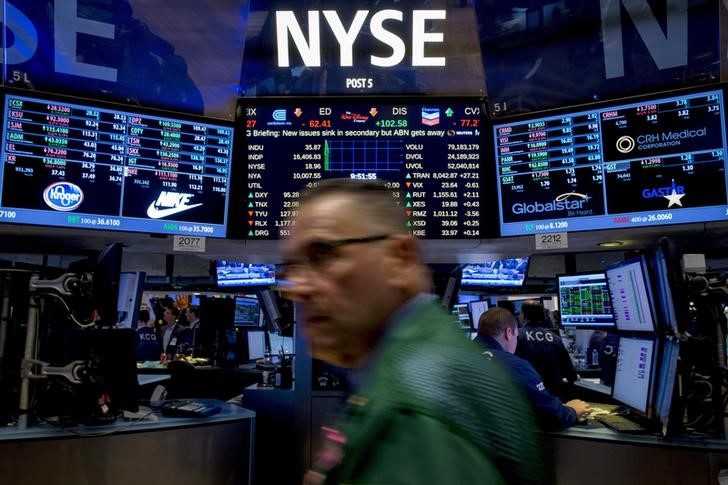By Gertrude Chavez-Dreyfuss
NEW YORK (Reuters) - Foreign investors have had to pay up to hedge U.S. dollar-denominated assets over the last year, but this has yet to stop them from plowing money into the U.S. corporate bond market, the world's largest.
Robust returns for U.S. corporate debt assets and expectations of solid U.S. economic growth for the remainder of the year have outweighed concerns about costly dollar hedges for many foreign buyers.
A surprise shift in the Federal Reserve's monetary policy stance earlier this year from a tightening bias to a neutral one helped unleash foreign demand for U.S. corporate bonds, which have recovered strongly from last year's losses.
The U.S. investment grade sector showed total returns of 5.6% so far this year, after a 2.2% loss in 2018, while the U.S. high yield market had an 8.3% return, after last year's loss of 2.3%, according to the Bank of America corporate bond indexes.
GRAPHIC: U.S. investment grade and high-yield indexes - https://tmsnrt.rs/2LqiLhe
"The much more benign outlook for interest rates has contributed to very sizable returns on fixed income including corporate bonds in the first part of the year," said Hans Mikkelsen, head of high grade credit strategy at Bank of America Merrill Lynch (NYSE:BAC) in New York.
The insatiable appetite for U.S. corporate bonds from foreign investors shows no signs of abating.
U.S. capital flows data from the U.S. Department of Treasury, which has a two-month lag, showed net foreign purchases of U.S. corporate bonds to the tune of $11.3 billion in the first two months of the year after selling about $15 billion in November and December of 2018.
Another gauge from EPFR Global showed U.S. investment grade funds had more inflows than outflows from foreign investors in the January to April period. In contrast, there were more foreign outflows than inflows from June to December last year.
GRAPHIC: Foreign inflows into U.S. corporate bonds png - https://tmsnrt.rs/2LmhCap
U.S. Treasury yields have come down since the Fed flagged a change in monetary policy, reducing the extra premium investors are willing to pay to hold these bonds instead of safer U.S. Treasuries.
U.S. corporate bonds are worth less when interest rates rise. When new issues come to market with higher coupon rates than older securities, those older ones become less attractive.
FOREIGNER INVESTORS UNDETERRED
Despite the change in Fed outlook, dollar hedges have remained high, although they're off last year's peaks, stemming from higher dollar borrowing costs in the money markets. That, however, has not deterred foreign investors from buying U.S. corporate paper.
"The U.S. has been the shining star in the global economy and this is where you're seeing very strong growth and very strong fiscal support over the last year," said Robert Brauns, portfolio manager for multi-strategy fixed income at BNP Paribas (PA:BNPP) Asset Management in New York.
"I think that has enticed investors to put some more money to work in the U.S.," he added.
At the same time, foreign investors, rather than face expensive hedging costs, have opted not to hedge their currency risks at all and this has worked to their advantage because the dollar has strengthened. The investor does not only get the yield from the fixed income paper, but the currency gain as well.
European investors buying fixed-income debt are still faced with fairly high dollar hedging costs, at around 3.1% using euro three-month forwards, slightly lower from the roughly 3.4% in late November 2018, Reuters calculations showed.
Analysts said the net return for a European investor buying U.S. high-yield debt still comes to 3.1%, less the currency hedging cost. In comparison, European high yield has a return of around 3.5%.
"If you have the view that the U.S. economy is strong and you believe the U.S. dollar is going to do well, you're not going to hedge the currency risk," BNP's Brauns said.
Japanese buyers of U.S. debt, on the other hand, have seen lower hedging costs this year currently at 2.85%, from a peak of 3.25% in November 2018, using 12-month forwards, the BNP official pointed out.
GRAPHIC: Lucrative no more - https://tmsnrt.rs/2DLDNAy
Bank of America's Mikkelsen believes hedging costs are on the way down because of the Fed's neutral monetary policy stance.
"Six months ago when you bought U.S. corporate bonds, you would be expected to roll into much more expensive currency hedges in 2019. Our market did not look good," said Mikkelsen.
"And now foreign investors could rationally expect cheaper foreign hedges because the market is pricing a rate ease. That's a shift of a hundred basis points between expecting the Fed to hike three times and now an ease," he added.
Japanese investors have thus begun buying foreign corporate bonds again this year, most of it in U.S. fixed income debt including Treasuries.
Japanese insurers, in particular, are looking for higher returns abroad by diversifying into riskier corporate bonds in the financial year that began last month.
"Everyone is cognizant of hedging costs. But investors have almost no choice," said Wen Lu, interest rates and volatility strategist, at TD Securities in New York. "The demand for yield across all asset classes is something of a necessity for a lot of investors."
